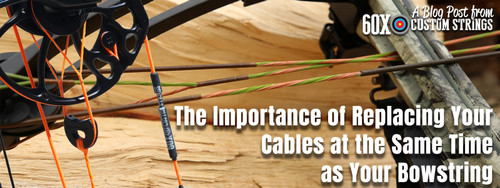The importance of replacing your cables the same time you replace your bowstring
Posted by Todd Lambright on Jul 31st 2023
Lately we’ve been getting a lot of calls from customers who have ordered bowstrings and no cables, only to later find out they also need the cables. It doesn't matter if you have a compound bow or a crossbow, the information contained in this blog post applies to both.
Why you should replace your cables when you replace your bowstring
Although we have no issue selling a bowstring separate from the cables, (we make more money when we do) it’s a real inconvenience to our customers in many ways. Here are a few:
- Multiple trips to the shop
- Typically, the customer doesn’t realize they need cables until their bow is in the hands of the technician working on it. Instead of making 1 trip to your local archery shop with a set of strings and cables, you now have to make a second trip with your cables in hand.
- Time
- In addition to spending time going back and forth to the shop, you also have to spend time placing another order, which also means more time for processing, building and shipping.
- Cost
- In addition to spending your time, you’ll also have to spend more money. It’s cheaper to buy a string and cable package than it is to buy a bowstring first then 1-4 cables (each bow make and model needs a different number of cables) individually later.
Cost difference example
Here is an example: For a standard color set of bowstring and cables for an Infinite Edge, the cost is $109.95. If you were to order the bowstring only for this 2-cam bow make and model, the cost would be $45 for a standard color. If you have to order cables (This bow requires 2 buss cables) separately, the cost is $40 each, so $80 for 2 for standard colors in this particular scenario. If ordering the bowstring and cables separately, it brings your total to $125.95. (Depending on your bow make and model, this could be more depending on the number of cams and number and type of cables.)
Purchased as a set = $109.95 Purchased individually = $125.95
Bowstring and cables work together
Think of a bowstring and cable set as a balancing act. The length relationship between the string and cables needs to stay consistent in order to keep the cams in the correct orientation/position/rotation, however you want to say it. The string pulls on the top of the cam, and the cables pull on the bottom. When the string and cable set is replaced, all the pieces break in at the same rate, keeping the cams in the optimal position. Even though the string and cables will elongate over time due to a few different things, the draw length and draw weight will remain somewhat close.
Uneven bowstring and cables equal unbalanced results
Now, let’s talk about what happens when you add a new string and don’t replace the cables. Say the cables are 2 years old and they have stretched/elongated 1/4" (some will have stretched more, some less). When the new string is installed, it throws off the balance between the string and cable lengths. Basically, this “short strings” the bow; it rolls the cams in toward the center of the bow from the optimal position.
- On a compound it will significantly shorten the draw length, reduce the poundage and reduce let off.
- On crossbows, since they don’t have draw stops, the cam will simply rotate further than where they were designed to operate when the bow is fully cocked. This will put excess stress on the cable as the point of the cable track that rolls into the cable harder than it should. I’ve seen a few crossbows that wouldn’t even cock when a new string was put on with some very stretched out cables.
The bad part is the cables can look perfect, but be stretched too far to twist back into spec.
Short-term solution
In some cases, if the cables aren’t stretched out too far, you can add enough twists to them when installing a new string to get the cams into the correct position. It will buy you a little bit of time, but in my experience, adding a bunch of twists to old cables is a short-term solution, as they will typically start showing wear pretty quick after doing this. Then, when you go to replace those cables, the string is already worn in, and you have to twist it to match the new cables. It’s a battle that will go on forever, costing more money and more trips to your bow technician. Not to mention the loss of consistency when all pieces of the set haven’t been exposed to the same stress, use and duty cycles. To me it would be like running 4 different tires on your car, yes it will typically get the job done, but not well and not 100% of the time.
Replace cables when replacing bowstring
Based on years of experience as an archer and as a bow technician, generally speaking, you should never replace just a single piece of a string and cable set. The only exception is if the set is fairly new and gets damaged by something other than normal wear and tear. An example of this would be cutting a string with a broadhead.








